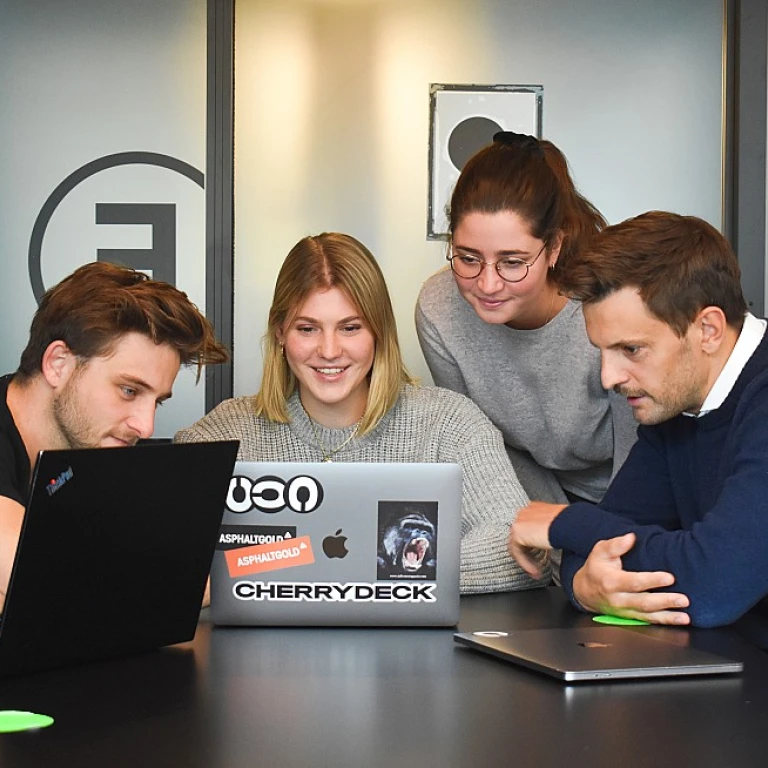
Understanding Recruitment Process Outsourcing
Embracing Recruitment Process Outsourcing
Recruitment Process Outsourcing (RPO) is a strategic initiative that allows organizations to manage their staffing needs effectively by delegating recruitment processes to a third-party service provider. This approach can significantly benefit companies by enhancing their capacity to attract and retain top talent, optimizing their recruitment strategies, and managing costs. By partnering with an RPO provider, businesses can access an extensive pool of candidates for various roles, tapping into specialized expertise that streamlines the hiring process. This strategic alliance not only maximizes efficiency but also ensures that companies are equipped with cutting-edge tools and insights, crucial for maintaining competitiveness in today's ever-evolving job market. An RPO firm acts as an extension of your HR department, providing flexible solutions that can cater to both high-volume recruitment needs and niche talent acquisition. The objective is to foster a dynamic hiring platform that is not only aligned with your business goals but also adaptable to changing industry trends. While the core benefit is operational efficiency, RPO also plays a crucial role in enhancing your company's brand perception among potential candidates. Expertly designed recruitment websites, supported by robust web design and user-friendly interfaces, help create a positive first impression. This is particularly important in recruitment marketing, as the layout and aesthetics of your recruitment site can greatly influence a candidate's decision to apply. If you're exploring the best ways to optimize your recruitment process, delving into the intricacies of RPO can be a game-changer. Enhancing recruitment with Bamboo Staff Solutions offers insights into how advanced staffing solutions can assist in building a resilient and agile recruitment strategy that positions your organization at the forefront of talent acquisition success.The Role of Website Design in Recruitment
Enhancing User Engagement with Thoughtful Design
Recruitment website design influences how effectively you attract and retain potential talent. A well-crafted site acts as an agency's digital storefront, where first impressions matter. Using strategically placed elements like buttons and fill strokes can significantly impact user interaction, leading candidates through a seamless job-seeking journey. Incorporating a user-friendly web design ensures that both clients and candidates have a satisfying experience on the platform. For recruitment agencies, employing design examples with intuitive navigation and well-organized content is crucial. Websites built with a clear understanding of recruitment marketing can communicate their brand's values and services efficiently.Optimizing for Seamlessness and Accessibility
Best recruitment sites prioritize easy navigation and accessibility. This means adapting web design practices that cater to various users, including those accessing the site on different devices or with diverse abilities. Recruitment websites can benefit from employing drag and drop features that make exploring job opportunities and learning about recruitment staffing more intuitive. A recruitment visit should feel effortless, supported by a coherent interface with strategically designed elements. The agency website should guide users with a clear branding strategy and call-to-action buttons, inviting them to learn more about the available roles or career resources.Integrating a Brand-Consistent Aesthetic
Consistent branding across the recruitment platform speaks volumes. A design website should have a distinct aesthetic that aligns with the agency's identity. From color schemes to font choices, every aspect needs to support the recruitment agency's vision and mission. A well-designed recruitment website not only attracts potential candidates but also reinforces the agency's status as a cutting-edge leader in its field. Emphasizing recruitment marketing through coherent visual appeal builds trust, encouraging candidates to engage with the brand more deeply. For more insights on how digital elements play a role, consider navigating the role of a digital talent management coordinator, a critical aspect of modern recruitment strategies. In essence, the role of website design in recruitment transcends mere aesthetics; it is pivotal in capturing attention, facilitating user engagement, and establishing a reliable digital presence.Key Elements of an Effective Recruitment Website
Key Components for Crafting a Recruitment Website
Creating a recruitment website that stands out requires attention to several elements that not only enhance the aesthetic appeal but also improve functionality. Incorporating these components effectively can make a significant difference in attracting top talent and engaging potential clients.- User-Centered Design: A recruitment website should prioritize the user experience. This involves ensuring that the site is easy to navigate, with clear and accessible paths for both job seekers and potential clients. The use of intuitive website templates and a drag-and-drop interface can simplify the process for users, making it more user-friendly.
- Visually Engaging Interface: The overall look of the site must reflect the brand identity of the recruitment agency. Utilizing consistent design elements like button placement and stroke width can maintain uniformity. Furthermore, a web design that aligns with cutting-edge trends in recruitment marketing will help to present a professional image.
- Effective Job Board Integration: An essential aspect of a recruitment website is the job board. Design examples show that integrating a job board that is easy to search and filter by candidates is a key feature. This function should be seamlessly built into the site to ensure a smooth user experience.
- Technology Integration: Leveraging new technology is crucial for recruitment websites. Platforms with robust functionality support recruiters by providing tools like recruitment visit tracking and analytics. This enables agencies to measure the success of their web design strategies effectively. More details on integrating technology can be found by exploring this link to additional resources.
- Responsive Design: With more users accessing websites from mobile devices, it is critical that recruitment sites are built with a responsive design that adapts to various screen sizes. This ensures that whether accessed from desktop, tablet, or smartphone, the site remains functional and visually appealing.
Integrating Technology in Recruitment Websites
Incorporating Cutting-Edge Technology on Your Platform
To thrive in the competitive world of recruitment, agencies must integrate the latest technologies into their websites. By leveraging technology effectively, a recruitment site can enhance user experience, streamline processes, and ultimately, attract the best talent for their clients. A pivotal aspect of website design in recruitment is the introduction of user-friendly features. These include drag-and-drop resume uploads and intuitive job boards that simplify the application process for job seekers. Moreover, a responsive web design ensures that your platform is accessible on various devices, catering to a wide range of users. Interactive elements, like chatbots, can provide real-time support to potential candidates, answering frequently asked questions and guiding them through the recruitment process. This kind of immediate assistance can greatly improve user interaction and satisfaction, making your recruitment website a go-to option for job seekers. Recruitment agencies can incorporate advanced analytics and tracking tools to monitor site activity. These tools help in understanding more about your audience, what they are looking for, and how they interact with your site. Such data insights empower agencies to refine their recruitment strategies, ensuring alignment with their marketing and branding efforts. The integration of artificial intelligence (AI) and machine learning (ML) in recruitment staffing can also lead to significant improvements. These technologies can automate repetitive tasks such as candidate screening and filtering, allowing recruitment agencies to focus on more nuanced aspects of talent acquisition. In the context of agencies aiming to maintain a cutting-edge platform, incorporating customizable website templates designed for the recruitment industry can be an efficient approach. These templates often come with pre-built sections optimized for different recruitment needs, promoting a seamless user experience. Ultimately, successful recruitment websites must continuously evolve with technological advancements. Not only does this keep the site competitive, but it also aligns with the dynamic nature of recruitment marketing, ensuring that businesses remain at the forefront of the industry.Challenges in Recruitment Website Design
Overcoming Design Hurdles in Recruitment Websites
Crafting recruitment websites that stand out in the crowded digital space involves navigating several challenges. These obstacles can affect not only the website design but also the overall recruitment strategy. Here are some common challenges and how to tackle them:- User Experience Design: The success of a recruitment website lies in its ability to be user friendly and intuitive. However, many sites struggle with finding the balance between aesthetic appeal and practicality. Prioritizing ease of navigation and ensuring that potential candidates can easily find job listings or agency services is crucial. Incorporating simple yet effective design examples, such as strategic placement of call-to-action buttons, can improve user engagement.
- Brand Consistency: Maintaining a strong and consistent brand presence across all website platforms is a frequent issue. Recruitment agencies must ensure their web design reflects their brand identity accurately, from stroke width to fill stroke elements, creating a cohesive and professional image that resonates with clients and candidates alike.
- Technological Integration: In today's cutting-edge digital environment, integrating technology like a job board or AI tools for recruitment marketing can be daunting. Selection of the best platforms and design templates that support seamless integration is necessary to enhance recruitment staffing efforts and optimize the user experience.
- Mobile Responsiveness: With an increasing number of job seekers accessing sites via mobile devices, developing a mobile responsive site is no longer optional. Ensuring that your recruitment platforms do not lose functionality or aesthetic appeal on smaller screens is essential for attracting top talent.
- Content Management: Keeping the content fresh and relevant on a recruitment website can be labor-intensive. Employing drag and drop web design tools and content management systems can help streamline this process, allowing recruitment agencies to present timely job opportunities and industry insights to their audience.
Measuring the Success of Your Recruitment Website
Evaluating Your Recruitment Websites' Impact
Determining the effectiveness of your recruitment website is crucial to ensure it aligns with your business goals and stands out in the competitive hiring landscape. Understanding metrics and clear performance indicators enable you to refine your web design strategy and deliver optimal results. Here’s how you can measure the success of your recruitment site effectively:
- Candidate Engagement: Analyze how candidates interact with your platform. Tools like Google Analytics can offer insights into user behavior on specific pages, helping to identify which aspects of your website design attract or repel visitors.
- Conversion Rate: This metric is vital; it helps gauge how many visitors transition into active candidates completing job applications. A well-designed recruitment website can boost conversion rates by providing clear calls-to-action and a user-friendly application process.
- Site Performance: From loading speeds to error-free functionalities, a recruitment platform's technical performance should be impeccable. Regular audits ensure that the site remains a reliable resource for prospective talent.
- Feedback Loops: Gathering feedback from users can provide unparalleled insights into areas requiring improvement on your web design. Consider deploying surveys to understand the user experience better and identify potential points of friction.
- SEO Metrics: An optimized site with strong SEO practices, including strategic keyword placement, not only makes it easier for job seekers to find job listings but also enhances the brand visibility in search engines.
- Referral Traffic and Sources: Understanding how visitors find your agency website can help define marketing strategies. Whether through direct, search engine referrals or social media platforms, identifying these sources is crucial for recruitment marketing.
Developing an impactful recruitment agency site that attracts potential candidates involves beyond just having a beautiful design. It requires an integration of technology, strategic marketing, and, most importantly, an understanding of what your clients are looking for. Regularly updated content, streamlined navigation, and a mobile-friendly interface are design examples that, when implemented effectively, support long-term growth and success.












